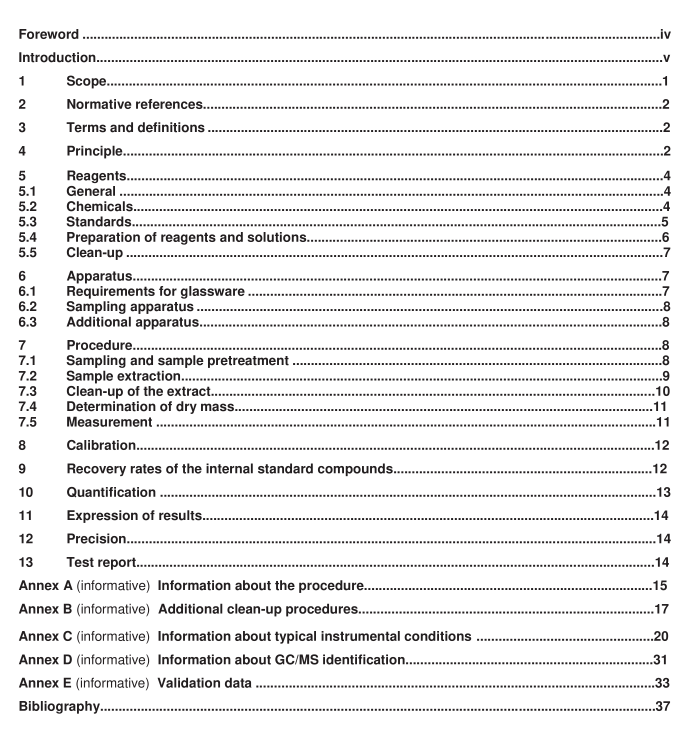BS EN ISO 23161 pdf download

BS EN ISO 23161 pdf download Soil quality — Determination of selected organotin compounds — Gas- chromatographic method
5.5 Clean-up
5.5.1 General requirements A silica or aluminium oxide clean-up is the minimum requirement. Further clean-up steps (aluminium oxide/silver nitrate, silica/silver nitrate, pyrogenic copper) may be applied if necessary (see Annex B). A recovery of > 80 % of the internal standards and target compounds shall be achieved for each clean-up step.
5.5.2 Silica gel for the clean-up column Heat silica gel (5.2.6) for at least 1 2 h at (500 ± 20) °C on a quartz plate in a muffle furnace. Ensure that the temperature does not exceed 520 °C. Allow the plate to cool in an oven to about 200 °C, transfer the silica to a wide-necked glass bottle and allow cooling to room temperature in a desiccator. Add water to the cooled silica until a mass fraction of 3 % is reached. Close the bottle and homogenize the contents for 2 h on a shaker.
5.5.3 Aluminium oxide for the clean-up column Activate aluminium oxide (5.2.7) by heating to 600 °C for a minimum of 24 h. Allow to cool in the oven to about 200 °C, transfer the aluminium oxide to a wide-necked glass bottle and allow cooling to room temperature in a desiccator. Add water to the cooled aluminium oxide until a mass fraction of 1 0 % is reached. Close the bottle and homogenize the contents for 2 h on a shaker.
5.5.4 Clean-up column Add about 5 g of adsorbent (5.5.2 or 5.5.3) to one column, and add about 3 g of drying agent. Ensure that the clean-up column is filled homogeneously, for example, by using hexane as a moistening agent during the filling process. Commercially pre-packed columns may be used as an alternative if the requirement for recovery is met.
5.5.5 Eluent for extract cleaning with silica gel A mixture of hexane (5.2.1 0) with a more polar solvent can be used as an eluent to obtain a quantitative elution of all organotin compounds. In routine work, about 5 % of acetone (5.2.9) or 20 % of dichloromethane (5.2.1 3) was used successfully. The concentration of polar solvent in hexane and the volume of total eluent should be determined prior to application.
5.5.6 Eluent for extract cleaning with aluminium oxide Generally, hexane (5.2.1 0) is used as the eluent. The volume of the eluent should be determined prior to application.
6 Apparatus
6.1 Requirements for glassware Customary laboratory glassware shall be used. All glassware and material that comes into contact with the sample or extract shall be thoroughly cleaned.
6.2 Sampling apparatus
Sampling devices shall not be a source of contamination. The use of stainless steel, glass or PTFE is recommended.
NOTE For example, poly(vinyl chloride) (PVC) can contain large amounts of organotin compounds.
Containers shall be inert and appropriate for storing and transport.
The size of the container shall be appropriate to ensure sampling of a suitable amount of solid to provide a representative sample and facilitate a determination in accordance with this International Standard within the calibrated working range.
6.3 Additional apparatus
Use ordinary laboratory apparatus and the following.
6.3.1 Centrifuge.
WARNING — The use of organic solvents in centrifuges needs to be assessed for safety reasons.
6.3.2 Glass column for clean-up, e.g. length 1 5 cm, inner diameter 1 cm, with frit, without a cock.
6.3.3 Shaker.
6.3.4 Ultrasonic bath or horn-type transducer.
6.3.5 Analytical balance, with suitable reading accuracy and range.
6.3.6 Concentration apparatus, e.g. rotary evaporator, Kuderna Danish.
6.3.7 Gas chromatograph, equipped with a high-resolution capillary column of suitable polarity and Injector, split or splitless, preferably with an automated sampling device (C.1 ).
6.3.8 Detectors (for typical detector configurations, see C.2). The following detector types may be used for the measurement of alkylated organotin compounds:
⎯ atomic absorption spectrometer (AAS), quartz oven, tin(Sn) lamp;
⎯ flame photometric detector (FPD), equipped with a cut-off filter of 590 nm or interference filter of 61 0 nm;
⎯ pulsed flame photometric detector (PFPD) equipped with a large pass-band filter working at 61 0 nm or 390 nm with a time-selective acquisition;
⎯ mass spectrometer (MS) for electron impact mode (EI-mode);
⎯ atomic emission detector (AED);
⎯ inductively coupled plasma/mass spectrometric detector (ICP/MS).









